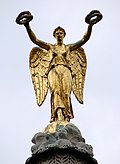Fontaine du Palmier
The Fontaine du Palmier (dt. Palm Fountain ) is a memorial on the Parisian Place du Châtelet in the 1st arrondissement . The monument was completed in 1808 and has been a monument historique since 1925 .
history
The fountain is one of the so-called Fontaines du décret de Saint-Cloud . With the decree of May 2, 1806, Napoleon Bonaparte ordered the construction of 15 street fountains in Paris to improve the drinking water supply for the Parisian population. Ten of the 15 wells have been demolished, mostly as part of Haussmann's redesign measures. Of the five remaining, only two are still in their original location.
Napoleon also commissioned his interior minister, Emmanuel Cretet, to erect a monument to victory for the battles won in the coalition wars . Crétet commissioned the engineer François-Jean Bralle , who also designed other fountains created under the decree, such as the Fontaine du Fellah and the Fontaine de Léda etc. a.
Under Haussmann the square was redesigned and the fountain was moved 12 meters to the west in 1858. Since then it has stood in the middle of the now symmetrical square, between the Théâtre du Châtelet and the Théâtre de la Ville and the axis of the Pont au Change .
layout
The name of the fountain is derived from the design of the 18 m high column. Instead of traditionally fluted and provided with acanthus leaves , the shaft is designed as a palm trunk and the capital is decorated with palm leaves. It may be a reference to Napoleon's Egyptian expedition . The names of the victorious battles can be read on five ribbons along the shaft, such as those at Austerlitz , Jena , Rivoli and at the pyramids, etc. a.
At the top of the column, above some hybrid creatures , a golden Victoria stands on a hemisphere with a bare chest and outstretched arms. She holds two wreaths in each hand . It is a copy from 1898. The original by Louis-Simon Boizot has been exhibited in the Musée Carnavalet since 1950 .
The lower part is again decorated with oak leaves and acorns. Around the base are four allegorical figures shaking hands. They represent strength, vigilance, wisdom and justice . Between the figures there are other attributes, such as a tablet of the law or the Gallic rooster . A Napoleonic eagle in a laurel wreath is depicted on the base . At the four corners there are horns of plenty that merge into water-spouting dolphin heads.
With the relocation in 1858, the fountain was given a further “floor”, so that the water now flows like a cascade into a new, round basin. Four water-spouting sphinxes by Henri-Alfred Jacquemart have also been added.
gallery
Place du Châtelet before the renovation in 1852 (Photo Charles Nègre )
Individual evidence
- ↑ Ministère de la Culture. Ministère de la Culture, accessed 3 September 2019 (French).
- ↑ Les fontaines du décret de Saint-Cloud. Retrieved August 25, 2019 .
- ↑ Jacques-Antoine Dulaure: Histoire de Paris et de ses monuments. 1846, accessed September 9, 2019 (French).
Coordinates: 48 ° 51 '27 " N , 2 ° 20' 50.3" E





